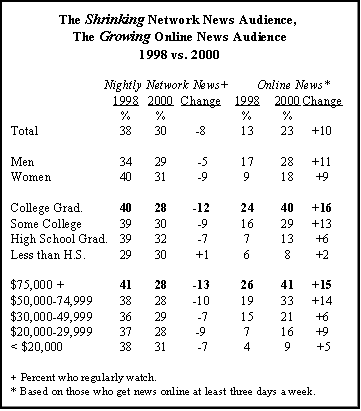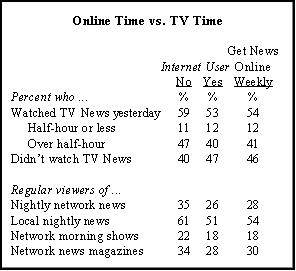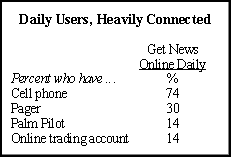
The same demographic groups which are moving away from the nightly network news in the greatest numbers are some of the very same groups which are moving toward online news use at the highest rates — more affluent, more well-educated Americans.
Indeed, as the number of people regularly getting news online has grown, so has the share of Internet news consumers who say they are using other news sources — like television — less often. Nearly one-in-five (18%) of those who get news online at least once a week say they now use other sources less often, up from 11% two years ago. Those who now use other sources less typically say the Internet is replacing television or newspapers in their lives.
What’s more, several measures show that the decline in the television news audience over the past two years has been greater among Internet users — including users who regularly go online for news — than among non-users. Two years ago, there was no difference in the number of Internet users and non-users who watched television news on a typical day — 59% in each group. Today, just 53% of Internet users watch television news on a typical day, while the number among non-users remains the same, at 59%.
Internet users are also spending less time watching TV news. The number of Internet users who spend a half-hour or more watching television news on a typical day dropped from 48% of viewers two years ago to 40% today. Time spent watching TV news also dropped by 8 percentage points among users who regularly get news online. But among non-users, there has been almost no decline in the time spent watching TV news on a typical day — 49% spent a half-hour or more in 1998, compared to 47% today.
Similarly, just one-in-four Internet users (26%) say they regularly watch a nightly network news broadcast, down from 35% two years ago. This compares with 35% of non-users who regularly watch the network news, down just 4 percentage points in two years. More detailed analyses show that Internet users are significantly less likely than non-users to watch the network news, even when controlling for demographic factors like sex, age, and education that are associated with both news viewership and Internet access. Taking these demographic factors and personal interest in the news into account, Internet users watch the network news at lower rates than non-users.1
Internet users are also slightly less likely than non-users to watch other network broadcast news programming, including morning shows like Today and Good Morning America and evening news magazines like 60 Minutes, 20/20, or Dateline. For example, 28% of Internet users say they regularly watch network news magazines, compared to just over one-third (34%) of non-users. While the differences between Internet users and non-users when it comes to these broadcast news programs are relatively small, they stand in contrast to other types of news sources — such as newspapers, radio, and many cable outlets — which Internet users are as likely, or more likely, to use.

Daily tracking of the public’s online activities also reveals the Internet’s growing status as a primary news source for many Americans. A separate daily tracking poll found that one-in-five Internet users (22%) get news online on a typical day, and most of these users go to Internet sites specifically to learn what is in the news.2 Among those who get news online on a typical day, 55% said they went to an Internet news site to read the news, while 43% said they happened to see news while they were doing something else online.
Narrowing Gender Gap
The Internet is becoming a news source in its own right, with one-in-three Americans (33%) now regularly getting news online, up from just 20% two years ago. This represents a solid majority of all Internet users — 61% — who go online for news at least once a week, including 27% of users who get news online every day.
Although men are still somewhat more likely than women to get news online, the gender gap is closing. Today, the population of regular Internet news consumers is comprised of 57% men and 43% women, a slight narrowing from the 61%-39% split in April 1998. What’s more, some 22% of those who get news online at least once a week are over age 50, compared to just 16% two years ago.
Americans who regularly get news online are more interested than non-Internet users in news about science and technology, business and finance, and sports. For example, 27% of those who get news online at least once a week say they follow news about science and technology very closely, compared to just 14% of those who don’t go online. More than twice as many Internet news consumers (22%) as non-users (10%) pay very close attention to business and finance news.

Notably, these topics are among the leading types of news that Internet users seek out when they go online. Fully 63% of those who get news online use the Internet to get updates on science and health, and nearly as many (59%) get technology news online. Half (53%) get business news online. These topics rank below only the weather, which remains the most popular type of online news — two-thirds (66%) of Internet news consumers say they get weather news and updates online.
Indeed, the popularity of the Internet as a source of weather updates is underscored by growth in the number of women getting weather online. Even as more women have started getting news online on a regular basis, the share of those women who get weather updates on the Internet has jumped substantially, as well. Two years ago, just 41% of women who got news online used the Internet for weather news, compared to 55% of men. Today, the numbers among Internet news consumers are nearly comparable, with 64% of women and 68% of men getting weather news online.
Other types of stories rate somewhat below these major topics — weather, science, health, and business — in popularity among those who get news online. Roughly four-in-ten online news consumers say they check the Internet for international news (45%) and sports news (42%). About as many (44%) get entertainment news online. Just over one-third get political news (39%) or local news (37%) online.
Heavy Users Constantly Connected
Those who are daily Internet news consumers — and are among the most heavily-connected Americans — underscore a number of the trends that are contributing to the Internet’s popularity as a new source. Those who get news online every day are disproportionately well-educated, younger men: 61% of daily Internet news consumers are men, 75% are under 50, and nearly half (47%) have a college education. Half (52%) have family incomes of $50,000 or more.

For these people, technology is clearly a plus. Three out of four (77%) not only go online on a daily basis, but also have a cell phone, pager, or Palm Pilot. Just as many (77%) say they like having access to all the information that comes through television, newspapers and computers, with just 19% saying they feel overloaded. This compares with a much narrower 52%-36% split among non-users.
Daily online news consumers are also heavily-engaged in the stock market and pay especially close attention to business news. Indeed, fully 42% of them personally trade stocks — compared to 21% of all Americans — and one-in-four (26%) made a trade within the last month. Half (52%) say they follow business and financial news closely most of the time, regardless of whether something important is happening, compared to just one-third of all adults (33%). Not surprisingly, an overwhelming majority (74%) get financial news online.




